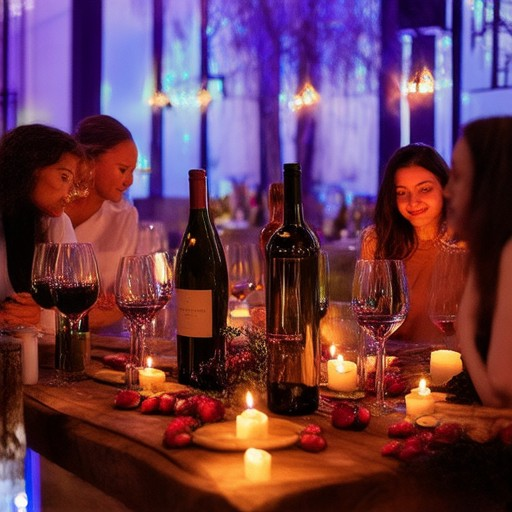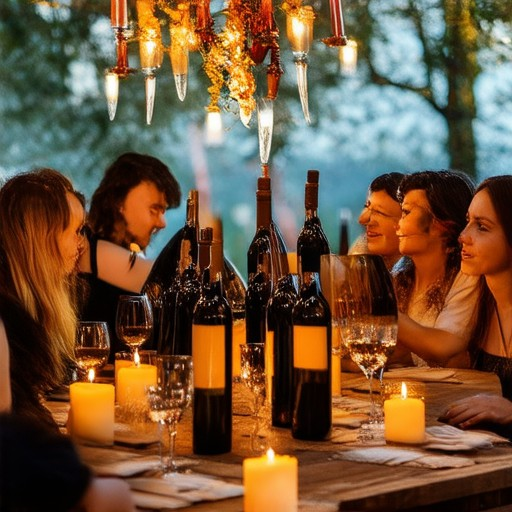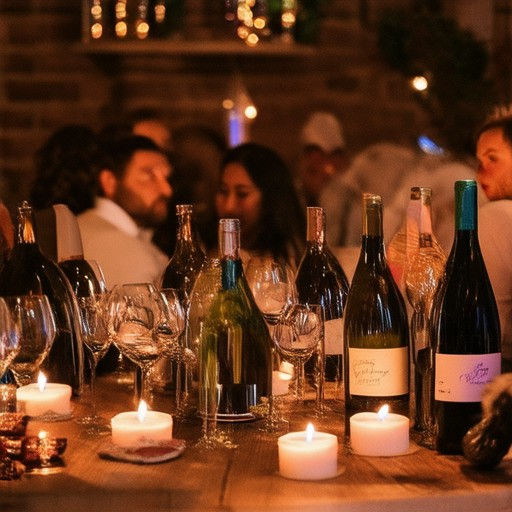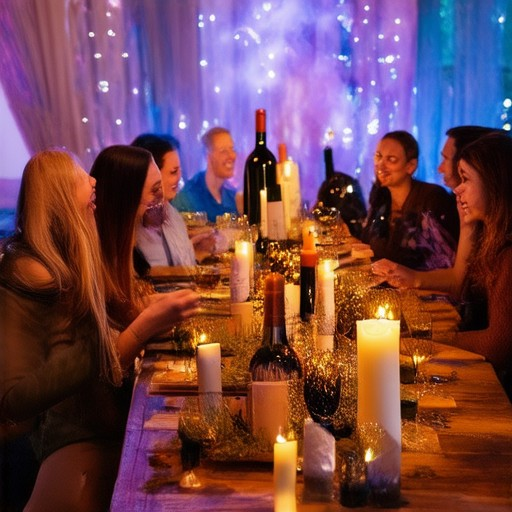Imagine gathering your closest friends around a table, each with a glass of perfectly paired wine, as the aroma of fine vintages fills the air. Hosting a wine tasting party with friends is more than just an event—it’s an unforgettable experience that combines flavors, stories, and connections. Whether you’re a seasoned wine enthusiast or new to the world of wine, this guide will walk you through everything you need to know to host a successful and enjoyable tasting session. From choosing the right location and creating a thematic atmosphere to mastering wine and food pairings and understanding the basics of wine tasting etiquette, this article covers all the essential tips to ensure your party is both educational and delightful. Let’s dive into how to make your wine tasting event one that your friends will never forget.
Key Takeaways
– Save Money: Host a wine tasting party at home or hire a venue to keep costs low. Basic tastings start at $10 per person, while premium options can exceed $150.
– Know When to Tip: Expect to tip 15-20% at high-end venues if service is exceptional.
– Free or Paid Tastings: Some wineries offer free tastings, while others charge $10-$30 per person. Always check reservation policies.
– Plan Ahead: Research venues, check for group discounts, and consider wine club memberships for special deals.
– Master Etiquette: Be respectful, stay informed, and enjoy the experience by trying new wines and learning about pairings.
– Explore Fine Vines: Use Fine Vines for expert guidance and top-tier resources to elevate your wine tasting events.

How to Host a Tasting Party
Hosting a tasting party can be a fun and educational experience. Here’s a step-by-step guide to help you plan and execute a successful event:
- Plan and Prepare
- Set a date and time for your party.
- Determine the number of guests and the duration of the event.
- Select a theme or focus area for the tasting (e.g., wine, beer, or spirits).
- Gather supplies like glasses, napkins, water bottles, and serving trays.
- Set Up the Space
- Choose a location with enough space for seating and movement.
- Arrange tables and chairs to accommodate your guests.
- Set up a designated area for serving and a separate space for notes or questions.
- Select Wines or Beverages
- Pick a variety of wines, beers, or spirits based on your theme.
- Consider including both popular and niche options for diverse tasting experiences.
- Prepare a list of descriptions or tasting notes for each selection.
- Create a Tasting Guide
- Design a printed guide or digital handout with tasting notes and pairing suggestions.
- Include tips on swirling, sniffing, and sipping to enhance the experience.
- Add sections on food pairings and serving temperatures.
- Conduct the Tasting
- Welcome your guests and introduce the event’s focus and schedule.
- Present each beverage one at a time, allowing time for discussion and feedback.
- Lead guided tastings and encourage interactive participation.
- Pair Foods with Drinks
- Offer a selection of appetizers or small bites to complement the beverages.
- Highlight complementary flavor profiles between foods and drinks.
- Provide tips on creating the perfect pairings.
- Engage Your Guests
- Ask open-ended questions to spark conversations and sharing.
- Facilitate discussions about preferences and experiences.
- Share interesting facts or stories about the beverages being tasted.
- Wrap Up the Event
- Thank your guests for attending and express your enthusiasm for the event.
- Collect feedback to improve future gatherings.
- Clean up and store any leftovers or unused materials.
What is the etiquette for wine tasting?
Tasting wine is a sophisticated experience that requires attention to detail and respect for the wine itself. Here are some essential guidelines to follow:
Preparation Before Tasting
- Arrive Early: Most wine tastings last about two hours, so arrive a bit early to fully engage with the wines and the hosts.
- Wash Hands: Begin by washing your hands to ensure your sense of smell isn’t affected by any previous scents.
- Use the Right Glassware: Each wine may require a specific type of glass, so pay attention to which glass is provided for each tasting.
Nosing the Wine
- Breathe In Slowly: Stick your nose about 12 inches away from the glass and take slow, deliberate breaths to capture the aroma.
- Swirl Gently: Swirl the wine in the glass to aerate it slightly, which releases more of its bouquet.
- Identify Aromas: Note any fruits, flowers, or spices in the nose. These are key indicators of the wine’s character.
Tasting the Wine
- Sip Small Amounts: Take only a small sip, not a gulp, to avoid overwhelming your palate.
- Swallow or Spit: After tasting, decide whether to swallow or spit the wine into the glass or a nearby container. Spitting is common and acceptable during tastings.
- Pay Attention to Flavor Profile: Notice the wine’s acidity, tannins, sweetness, and body. These factors contribute to its overall quality.
Observations and Sharing
- Notice Appearance: Look at the wine’s color, clarity, and bubbles (if any). These can give clues about age and region.
- Share Observations: If you notice something unique about the wine, share your thoughts with the group or host.
Etiquette Tips
- Don’t Overpour: Pour only a small amount into your glass at a time to avoid wasting any wine.
- Be Respectful: Refrain from talking loudly or interrupting others during the tasting process.
- Stay Focused: While socializing is enjoyable, try to maintain focus on the wines to fully appreciate their nuances.
For more detailed wine tasting guides and expert insights, visit our wine tasting guide section. Explore our curated articles on wine pairings and learn how to enhance your tasting experience with the right food pairings.

How to Make Wine Tasting More Fun
To elevate your wine tasting experience, consider incorporating these engaging activities and tips:
- Blind Wine Tasting Games
Begin with a blind taste test by pouring small portions (about 2 ounces) into each guest’s glass. Provide paper and pencils for note-taking and encourage guests to share their observations. This sparks lively discussions and adds a fun element as they guess the wine’s origin or grape variety. - Interactive Wine Pairing Challenges
Create a game where guests match wines with specific food pairings. Offer options like pairing a bold red with hearty meats or a crisp white with fresh seafood. This adds a layer of strategy and makes the event more interactive. - Wine Region Trivia
Before the tasting, quiz guests on wine regions using questions like, “Which country is known for its Sauvignon Blanc?” This sets the tone and builds excitement for the tasting itself. - Comparative Tastings
Organize a session where guests compare wines from the same grape variety but different regions. Highlight how terroir affects flavor profiles, making it both educational and entertaining. - Aroma and Flavor Descriptions
Encourage guests to use descriptive language, focusing on nose and palate notes. Offer prompts like, “What fruit or spice does this wine remind you of?” to guide the conversation. - Wine Cocktail Mixology
Add a twist by creating signature cocktails using wine as a base. Examples include the “Bordeaux Basil Mojito” or “Caribbean Rum Punch with Red Wine.” This introduces a creative aspect to the tasting. - Group Wine Blending
Let guests mix their own bottles by blending different varietals. Provide guidelines on balancing acidity, tannins, and sweetness, then let them experiment and taste the results. - Wine Art Creation
After tasting, invite guests to create visual art inspired by the wines they tasted. This could be abstract paintings, collages, or even wine bottle sculptures, turning the event into a creative expression. - Wine Tasting Notes Exchange
At the end of the session, have guests share their tasting notes with the group. This fosters a sense of community and provides valuable insights for everyone. - Music and Ambiance
Set the mood with curated playlists featuring songs that evoke the essence of wine regions or cultural vibes associated with the wines being tasted. This enhances the overall experience.
By combining these elements, you can transform a standard wine tasting into an engaging and memorable event. Remember to always enjoy the process and let your guests’ enthusiasm shine!
Learn more about wine tasting techniques and grape varieties .

How Much Does a Wine Tasting Event Cost?
Wine tasting event costs vary widely depending on the venue, the number of wines tasted, and the amenities offered. Here’s a breakdown of what you can expect:
- Basic Tastings: These are often the most affordable option, costing around $10 to $30 per person. They typically include 3-5 wines and may not include food.
- Standard Tastings: Mid-range wine tastings usually cost between $25 and $50 per person. These sessions often include 5-8 wines, paired with light snacks or appetizers.
- Premium Tastings: High-end wine tastings can range from $50 to $150 or more per person. These events may feature rare or premium wines, gourmet food pairings, and exclusive access to winemakers.
Additionally, some venues offer group discounts for larger parties, while others may charge extra for VIP or reserve tastings. It’s also common to see seasonal promotions or discounts during off-peak times.
To find the best wine tasting experiences, consider visiting Fine Vines , a trusted resource for wine education and event planning. Their expert guides provide detailed insights and recommendations for organizing and enjoying wine tasting events.
Do you tip wine tasting servers?
Tipping wine tasting servers is a matter of personal preference and the establishment’s custom, but it is generally appreciated when service exceeds expectations. Here are some guidelines:
- Venue Type: In high-end wine bars or private tastings, tipping is often expected and ranges between 15-20% of the total cost.
- Server’s Role: If the server provides valuable insights, pours wines accurately, and maintains a welcoming atmosphere, a tip is considered appropriate.
- Group Size: For shared tastings, consider tipping per person to distribute the cost fairly.
- Personal Preference: If you had an excellent experience, showing gratitude with a small gesture is a kind way to acknowledge their effort.

Do You Pay for Wine Tastings?
Whether you pay for wine tastings depends on the winery and the experience you’re seeking. Here’s a breakdown of what to expect:
- Free Tastings:** Many wineries offer complimentary tastings, often as part of a visit or with a purchase. These are great opportunities to sample a variety of wines without an upfront cost.
- Paid Tastings:** Some wineries charge a fee for tastings, which may range from $10 to $30 per person. This fee typically includes access to multiple wines and sometimes food pairings.
- Reservations Required:** Some premium wineries require reservations for tastings, especially during peak hours. Check online or call ahead to confirm policies and fees.
To make the most of your tasting experience:
- Plan Ahead:** Research wineries online to understand their tasting fees and reservation policies before visiting.
- Bring the Right Attitude:** Be respectful and open-minded when participating in tastings. Remember, the goal is to enjoy the wines and learn about them.
- Stay Informed:** Keep in mind that some wineries may offer discounts or waived tasting fees for members of their wine clubs or for purchasing multiple bottles.
For a seamless wine-tasting experience, consider exploring Fine Vines, a trusted resource for wine education and vineyard insights. Their expert guides and pairing tips can enhance your journey into the world of wine. Visit [Fine Vines](https://finevines.net/) to discover more about wine tastings and beyond.



0 Comments